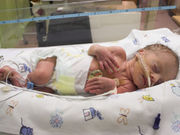Risk of central line-linked bloodstream infections not up for peripherally inserted central catheters
MONDAY, Nov. 16, 2015 (HealthDay News) — Infants with peripherally inserted central catheters (PICCs) do not have increased risk of central line-associated bloodstream infections (CLABSIs) with increased dwell time, according to a study published online Nov. 16 in Pediatrics.
In an effort to examine the effect of catheter dwell time on the risk of CLABSI, Rachel G. Greenberg, M.D., from the Duke Clinical Research Institute in Durham, N.C., and colleagues conducted a retrospective cohort study involving 13,327 infants (median postmenstrual age, 29 weeks) with 15,567 catheters and 256,088 catheter days. Survival curves were generated for each week of dwell time, and hazard ratios for CLABSI were estimated at each week.
The researchers found that the overall CLABSI incidence was 0.93 per 1,000 catheter days. There was no correlation seen for increased dwell time with increased risk of CLABSI for PICCs (93 percent of catheters). The incidence of infection was significantly higher in weeks seven and nine versus week one for tunneled catheters (7 percent of catheters).
“Clinicians should not routinely replace uninfected PICCs for fear of infection but should consider removing tunneled catheters before week seven if no longer needed,” the authors write.
One author disclosed receiving financial support from Cempra Pharmaceuticals and industry for neonatal and pediatric drug development.
Full Text (subscription or payment may be required)
Copyright © 2015 HealthDay. All rights reserved.








